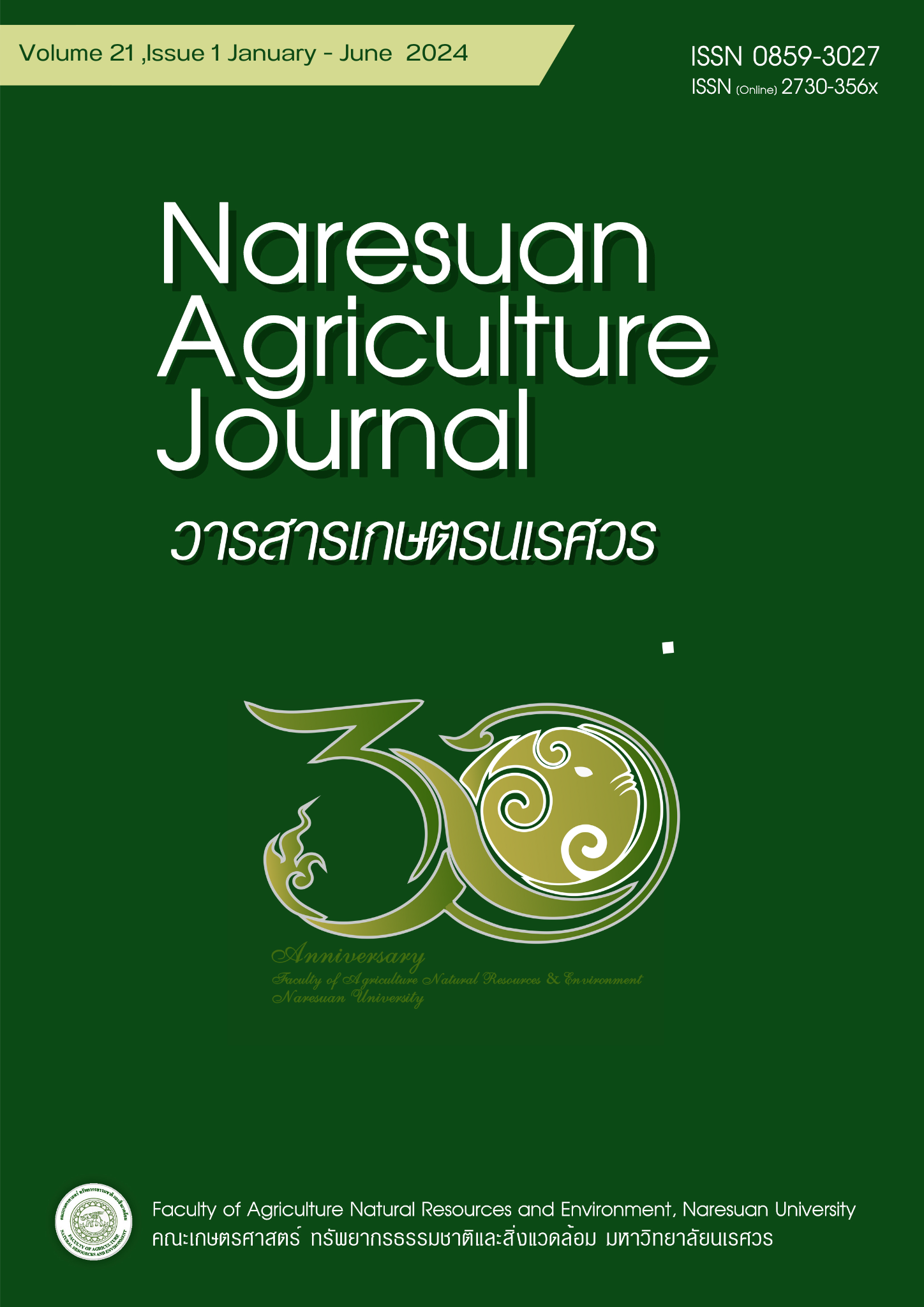Application of plants essential oil formulas combined with carbon dioxide in controlling stored product insects การใช้สูตรน้ำมันหอมระเหยจากพืชในการควบคุมแมลงศัตรูในโรงเก็บ
Main Article Content
Abstract
The fumigation efficiency of essential oil formulas contained star anise (S) sweet fennel (D) and lemon grass (L) at different ratios in combination with carbon dioxide at least 80% by volume against the maize weevil at 18 µl/L air were evaluated. Obtain result after 6 hr informed that the formula of S3L1 at 10% concentration presented 79.82% mortality, followed by formulas S3L2 and S3D1 caused 63.92-69.76% and 59.28-66.36 % mortality, respectively. Simulation of field test was initially performed when number of maize weevil was introduced into test tube and inserted in rice sack and then the fumigation was done for 24 hr. It was found that carbon dioxide in combination with ethanol (control), the solvent of essential oil caused 6.7% mortality, whereas, essential oil formula S3L1 10% in combination with carbon dioxide caused 93.99%. However, longer fumigation times of 48 hr, they showed similar result and this essential oil formula still performed the most effectiveness with 100% mortality. Besides, the fumigation test of this essential oil formular was also conducted against flea beetle and saw-toothed grain beetle, in which caused 99.52-100% mortality of insects. As for the fumigation against 3 species of insects: corn weevil, red flour beetle and saw-toothed grain beetle presented the percentage mortality of insects was 99.52-100%. In case of the differentiation of the quality of milled and steamed rice interm of their color and quality aspects were initially slightly different.
Article Details

This work is licensed under a Creative Commons Attribution-NonCommercial-NoDerivatives 4.0 International License.
บทความในวารสารเกษตรนเรศวรที่ได้รับการตีพิมพ์ เป็นลิขสิทธิ์ของ คณะเกษตรศาสตร์
ข้อความที่ปรากฏในบทความแต่ละเรื่องในวารสารนี้เป็นความคิดเห็นส่วนตัวของผู้เขียนแต่ละท่านไม่เกี่ยวข้องกับคณะเกษตรศาสตต์ฯ
References
กวีวัฒน์ จาวสุวรรณวงษ์, จรงค์ศักดิ์ พุมนวน, และอำมร อินทร์สังข์. (2556). ประสิทธิภาพของสูตรน้ำมันหอมระเหยจากจันทน์แปดกลีบ (Illicium verum Hook.f.) และเทียนข้าวเปลือก (Anethum graveolens Linn.) ในการควบคุมแมลงศัตรูในโรงเก็บ. ใน การประชุมวิชาการอารักขาพืชแห่งชาติ ครั้งที่ 11. ณ โรงแรมเซ็นทาราคอนเวนชันเซ็นเตอร์ อำเภอเมือง จังหวัดขอนแก่น. หน้า 1069-1076. วันที่ 26-28 พฤศจิกายน 2556.
กวีวัฒน์ จาวสุวรรณวงษ์. (2558). ประสิทธิภาพของน้ำมันหอมระเหยจากพืชสมุนไพรร่วมกับคาร์บอนไดออกไซด์ ในการควบคุมแมลงศัตรูในโรงเก็บ. วิทยานิพนธ์ระดับปริญญาโท, คณะเทคโนโลยีการเกษตร, สถาบันเทคโนโลยีพระจอมเกล้าเจ้าคุณทหารลาดกระบัง. 76 หน้า.
นภัส ยิ้มกรุง, วีรเทพ พงษ์ประเสริฐ,ปาณิสรา เทพกุศล, ไสว บูรณพานิชพันธุ์ และเยาวลักษณ์ จันทร์บาง. (2562). พลวัตประชากรและการควบคุมมอดข้าวเปลือกในโรงเก็บเมล็ดพันธุ์ข้าว. วารสารเกษตร, 35(2), 295-302.
พูนพัฒน์ พูนน้อย, เบญญทิพย์ มหาเทพ, และภิญญาพัชญ์ พุฒตาล. (2553). การทำลายไข่มอดในข้าวอินทรีย์ด้วยคลื่นไมไครเวฟ. วารสารวิจัยและพัฒนา มจธ, 33(1), 39-48.
ไพโรจน์ วิริยจารี. (2545). การวางแผนและการวิเคราะห์ทางประสาทสัมผัส. ภาควิชาวิทยาศาสตร์และเทคโนโลยีการอาหาร คณะอุตสาหกรรมเกษตร มหาวิทยาลัยเชียงใหม่, เชียงใหม่.
รุจิรา ปรีชา, สุเทพ ฤทธิ์แสวง, และสุนันทา วงศ์ปิยชน. (2551). ประสิทธิภาพของพืชสมุนไพรต่อการเก็บรักษาข้าวกล้องและข้าวซ้อมมือ. ใน การประชุมวิชาการข้าวและธัญพืชเมืองหนาว ประจำปี 2551 ชลบุรี. วันที่ 8-10 เมษายน, 352-362.
วริยา ธนะศิรังกูล, จรงค์ศักดิ์ พุมนวน, และอำมร อินทร์สังข์. (2556). ประสิทธิภาพของน้ำมันหอมระเหยจากพืชสมุนไพรบางชนิดต่อตัวเต็มวัยของมอดแป้ง มอดหัวป้อม และด้วงงวงข้าวโพด. ใน การประชุมวิชาการพืชสวนแห่งชาติ ครั้งที่ 12. ณ ศูนย์นิทรรศการและการประชุมไบเทค กรุงเทพฯ. วันที่ 9-12 พฤศจิกายน 2556.
ฤชุอร วรรณะ และจิราภรณ์ กระแสเทพ. (2566). ผลของผลิตภัณฑ์จากหญ้าดอกขาวที่มีต่อการเกิดออกเป็นตัวเต็มวัยของด้วงงวงข้าวโพด. วารสารแก่นเกษตร, 615-621.
Abbott, W.S. (1987). A method of computing the effectiveness of an insecticide. 1925. Journal of the American Mosquito Control Association, 3, 302-303.
Azad, M. A. K. (2012). Effect of botanical extract on pest controlin Brinjalfield. Journal of Environmental Sciences & Natural Resources, 5(2), 173-176.
Delate, K.M., Grace, J.K. & Armstrong, J.W. (1995). Carbon dioxide as a potential fumigant for termite control. Journal of Pesticide Science, 44, 357-361.
Leesch, J.G. (1995). Fumigant action of acrolein on stored-product insects. Journal of Economic Entomology, 88, 326-330.
Manna, C. D., Jayas, D. S., White, N. D. G. & Muira, W. E. (1999). Mortality of cryptoleste ferrugineus (Stephens) exposed to changing CO2 concentration. Journal of Stored Products Research, 35, 385-395.
Page, B.B.C., Bendall, M.J. & Carpenter, A. (2002). Carbon dioxide fumigation of Thrips tabaci in export onions. New Zealand Plant Protection, 55, 303-307.
Pimentel, M.A.G., Faroni, L.R.D., Totola, M.R. & Guedes, R.N.C. (2007). Phosphine Resistance, Respiration Rate and Fitness Consequences in Stored-Product Insects. Pest Management Science, 63, 867-881.
Pourmirza, A. A. & Tajbakhsh, M. (2008). Studies on the toxicity of acetone, acrolein and carbon dioxide on stored-product insects and wheat seed. Pakistan Journal of Biological Sciences, 11, 953-963.
Rajendran, S., & Sriranjini, V. (2008). Plant products as fumigants for stored-product insect control. Journal of Stored Product Research, 44, 126-135.
Sittisuang, P., & Nakakita, H. (1985). The effect of phosphine and methyl bromide on germination of rice and corn. Journal of Pesticide Science, 10, 461-468.
WMO. (1995). Scientific Assessment of Ozone Depletion: 1991. World Meteorological Organization global ozone research and monitoring project, Report No. 37, World Meteorological Organization of the United Nations, Geneva, Switzerland
Yadav, D.N., Anand, T., Sharma, M., & Gupta. R.K. (2014). Microwave technology for disinfestation of cereals and pulses: An overview. Journal of Food Science and Technology, 51(12), 3568-3576.

